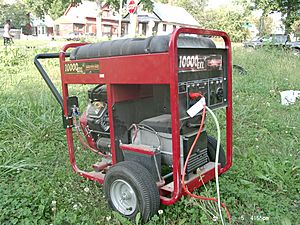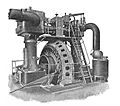Electrical generator facts for kids
A generator usually means a machine that makes electrical energy. It has a generator head with wires, spinning inside a magnetic field. The resulting electromagnetic induction makes electricity flow through the wires. Hybrid electric vehicles carry a generator powerful enough to make them go. The biggest generators don't go anywhere; they stay in power stations.
Different things can be used to make the generator head spin. Some small ones are cranked by someone's arms or legs. Bigger ones are connected to an engine. The biggest ones use a steam turbine or hydroelectric water power. Some use wind power. Whatever makes it turn, the generator converts this energy into electrical energy.
Some portable generators have an internal combustion engine. They are harmful when used indoors because they make carbon monoxide.
Contents
Components
Simple generators have:
- a rotor, which is the moving part of the generator
- an axle
- a magnet
- brushes
Some kinds have:
- a commutator, which is a switch that reverses the current
- a power supply to start the generator
Related pages
Images for kids
-
U.S. NRC image of a modern steam turbine generator (STG).
-
Early Ganz Generator in Zwevegem, West Flanders, Belgium
-
The Faraday disk was the first electric generator. The horseshoe-shaped magnet (A) created a magnetic field through the disk (D). When the disk was turned, this induced an electric current radially outward from the center toward the rim. The current flowed out through the sliding spring contact m, through the external circuit, and back into the center of the disk through the axle.
-
Ferranti alternating current generator, c. 1900.
-
The Athlone Power Station in Cape Town, South Africa
-
Hydroelectric power station at Glen Canyon Dam, Page, Arizona
-
Protesters at Occupy Wall Street using bicycles connected to a motor and one-way diode to charge batteries for their electronics
See also
 In Spanish: Generador eléctrico para niños
In Spanish: Generador eléctrico para niños













